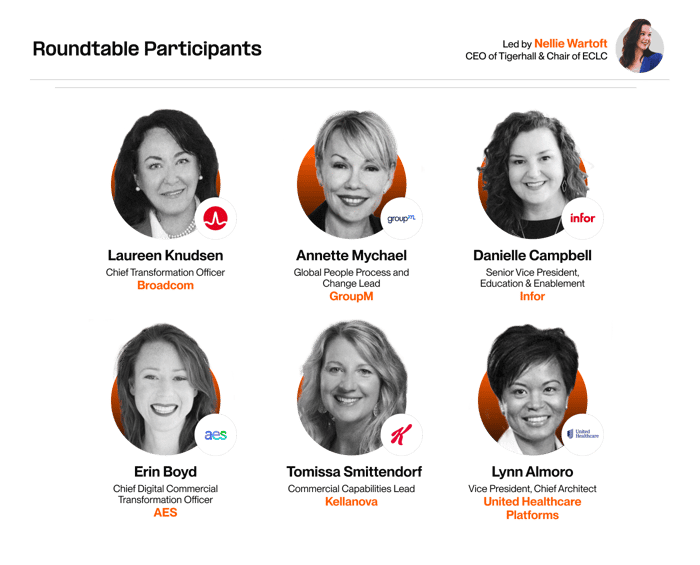The Executive Council for Leading Change (ECLC) assembled a roundtable of seasoned executives to dig into the topic of Executive Education & Enablement around Change. This executive brief summarizes the key insights from that conversation, outlining the practical approaches of securing C-suite buy-in, educating leaders on the process of change, and ensuring that senior executives are not just on board but actively driving the transformation within their spheres of influence.

5 Key Strategies for Executive Change Enablement:
The discussion at the roundtable surfaced several key strategies that are essential for enabling executives to lead and adapt to organizational change:
1. Influencing Through Allies
Participants agreed that influencing allies within the C-suite is a critical tactic. By securing support from key individuals, presenting new initiatives becomes a smoother process. Lynn Almoro emphasized the importance of understanding who the influential C-suite members are and aligning with them early on.
This approach creates a network of support that, by the time a proposal is presented, there's a chorus rather than a single voice advocating for change.
2. Understanding Individual Motivators
The conversation underscored the importance of tapping into the personal aspirations and business impacts that matter to each executive. Laureen Knudsen from Broadcom pointed out that tailoring the change narrative to align with each executive's interests ensures relevance and heightened engagement.
Executives are more inclined to support initiatives that resonate with their individual goals and departmental objectives.
3. Creating a Champion Network
Handpicking influential leaders to act as change champions was another successful tactic shared. Tomissa Smittendorf from Kellanova discussed how leveraging the credibility of these champions to drive adoption has been effective in her experience. Tomissa explains that they targeted influential leaders in the organization and brought them along from the inception.
This strategy not only amplifies the intended message but also serves to create a gravitational pull, drawing more supporters to the cause.
4. Addressing Fear and Resistance
Despite the best-laid plans, fear and resistance can still obstruct the path to change. Danielle Campbell from Infor shared how individualized strategies to engage executives and align them with transformation objectives have been central to her approach.
Tackling this requires a compassionate approach that respects individual concerns while gently guiding executives toward a shared vision for the future.
5. Visual Communication of Change
Tomissa Smittendorf from Kellanova shared the utility of using a color-coded system (stop, start, continue) to provide a clear visual representation of changes, which made transitions appear manageable and balanced.
This approach underscores the importance of clear, accessible communication in facilitating understanding and buy-in.
5 Successful Approaches and Tactics:
The executives also shared successful approaches and tactics that contributed to effective change strategies:
1. Micro-advocacy
As stated above, securing support from influential leaders within the organization can create a domino effect, encouraging wider executive buy-in. This approach of building support incrementally was echoed by Annette Mychael from GroupM and other participants as a subtle yet powerful method of driving change.
2. Swag and Visibility
Lynn Almoro shared an innovative approach of using branded swag to generate curiosity and engagement among the C-suite. The swag serves as a conversation starter and an indirect promotion of the initiative. This tactic of creating a visible and tangible connection to the change initiative proved effective in her experience.
3. Leveraging Digital Media
Embracing platforms like Tigerhall to create engaging, bite-sized content was highlighted as a method for promoting effective change throughout the organization and among executives and employees, a tactic that has been leveraged effectively by Danielle Campbell and Tomissa Smittendorf.
4. Encouraging Habit Formation
A recurring theme was the importance of a gradual approach to embedding new practices. Leaders like Lynn Almoro spoke to the necessity of allowing time for new habits to form, ensuring lasting change.
5. Candid Conversations
Laureen Knudsen shared the significance of eliciting honest feedback by asking open-ended questions like "What do you think are the barriers of adoption?" This approach revealed executives' personal and departmental concerns and helped in crafting more effective change strategies.
2 Common Challenges Faced
The discussion also touched on overcoming challenges like scripted communication and seamlessly integrating change into daily operations.
1. Overcoming Scripted Communication
Moving away from traditional, heavily scripted communication towards more genuine and conversational interactions proved difficult. This challenge, especially prevalent for those uncomfortable with modern, informal media, was noted by Danielle Campbell.
2. Integrating Change into Daily Work
Ensuring that change initiatives were not viewed as separate from day-to-day activities required intentional effort and strategic communication, a challenge that Annette Mychael found particularly notable, with limited communication platforms.
Conclusion
The executive roundtable hosted by the Executive Council for Leading Change (ECLC) unveiled a multifaceted approach to leading change at the highest levels of an organization. From strategic alliances to personal engagement, from addressing fears to highlighting wins, the conversation reflected a deep understanding of the human elements at play in executive education and enablement around change.
This roundtable discussion underscores the evolving nature of leadership in the face of global business challenges. As organizations increasingly navigate remote work and digital transformation, the strategies discussed here align with the broader trend of fostering adaptability and resilience in leadership.
These insights are pivotal for current change initiatives and also foundational for the future dynamics of strategic leadership. They contribute directly to ECLC’s mission of advancing leadership expertise in corporate change, demonstrating how visionary leaders can collaborate, plan, and create practical solutions for the intricate challenges of leading major shifts in large organizations.
The Executive Council for Leading Change
The Executive Council for Leading Change (ECLC) is a global organization that brings executives together to redefine the landscape of organizational change and transformation. Our council's aim is to advance strategic leadership expertise in the realm of corporate change by connecting visionary leaders. It's a place where leaders responsible for significant change initiatives can collaborate, plan, and create practical solutions for intricate challenges in leading major shifts in large organizations.
In a world where change is constant, we recognize its crucial role in driving business success. ECLC’s mission is to create a community where leaders can excel in guiding their organizations through these dynamic times.
Interested in joining ECLC? Learn the membership criteria and sign-up below.
To download this executive brief, click here.

